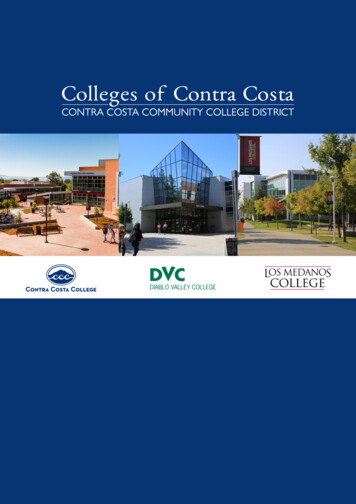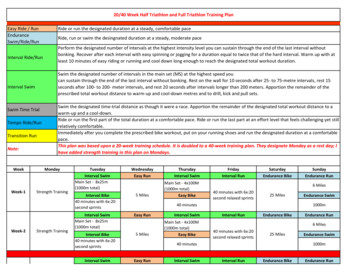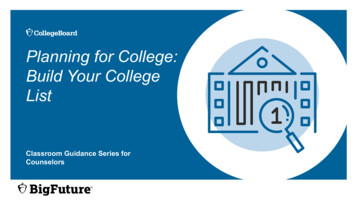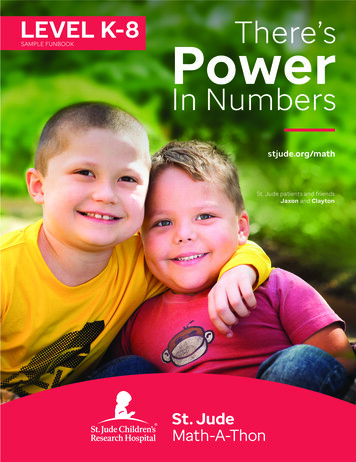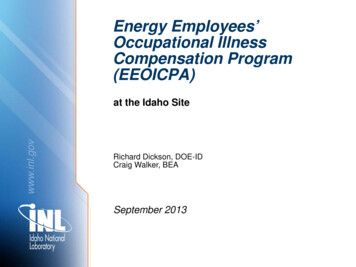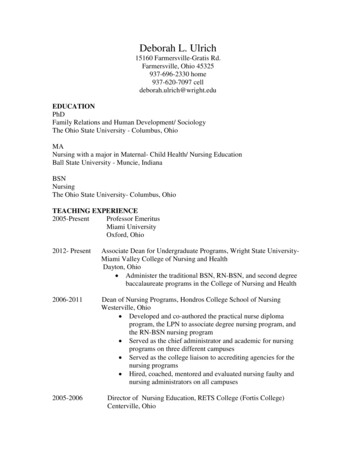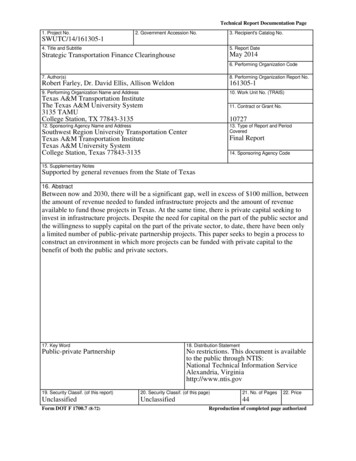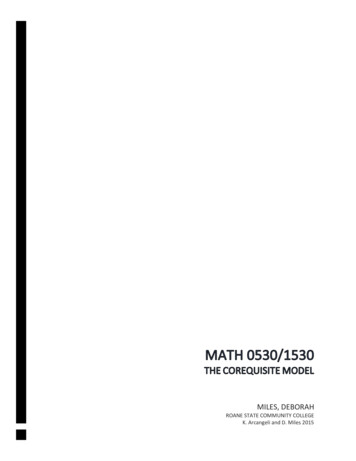
Transcription
MILES, DEBORAHROANE STATE COMMUNITY COLLEGEK. Arcangeli and D. Miles 2015
TABLE OF CONTENTSMATH 0530 STATISTICAL PRINCIPLESBeginning of the Semester Procedures1Math 0530/1530 Co-requisite Calendar2First Day Agenda30530 Syllabus5Notebook Guidelines8Day 1 – 28 Student Handouts9MATH 1530 PROBABILITY AND STATISTICS (Non-Calculus Based)1530 Syllabus11530 Contents Flowchart4Chapter 1. Introduction to Statistics5Chapter 2. Summarizing and Graphing Data14Chapter 3. Statistics for Describing, Exploring, and Comparing Data21Chapter 4. Probability33Chapter 5. Discrete Probability Distributions42Chapter 6. Normal Probability Distributions50Chapter 7. Estimates and Sample Size58Chapter 8. Hypothesis Testing66Chapter 10. Correlation and Regression78APPENDICESMATH 1530 Study GuidesTest 11Test 28Test 311Test 414MyLabsPlus Gradebook17MyLabsPlus Technical Information19Feedback Journal21
STATISTICAL PRINCIPLES2
Beginning of the Semester ProceduresWhat to do the week prior to the start of classes. Review the material and layout of your course on D2L/Momentum. This is the time when you can add in any of your own personal study guides and supplements into the“Contents” section. Modify the Instructor Information sheet with your personal information. Confirm your course rosters within Banner. Recommend reprinting the roster immediately prior to the start of class and before each class until thelast day of LDA’s. Remember that the course roster listed within Banner is the “Official” roster and that the rosters listedwithin Momentum and MyLabsPlus are not. Access to some short training videos to help learn to navigate through t/videos/index.html.Before Each Class During Semester Look over mini-lecture to familiarize yourself with concepts and vocabulary. Do 0530 Lab before assigning it. Review previous 1530 section notes so that you can help your students with their 1530 homework.1
MATH 0530/1530COURSE 24252627282MATH 0530TopicsOrientation, Study Skills, Time ManagementWhole Numbers: Place Value, Rounding, Estimating, Problem Solving, VariableExpressionsMUST HAVE TI-83/84 CALCULATOR! Exponents, Square Roots, Fractions,Order of OperationsDecimals, Ratios, Percent, ConversionsApplications of PercentOperations on Real Numbers, Scientific NotationReview of Types of Data, Sampling Methods, Types of GraphsReview of Measures of Center and VariationComprehensive Review of Chapters 1 – 3 and Basic SkillsReview Basic Skills and Concepts of ProbabilityReview Fractions, Complements, Contingency TablesProbability Distributions, Discrete vs. Continuous, InequalitiesDiscrete Probability Distributions, Maximum and Minimum Usual ValuesReview of Probability and Discrete Probability DistributionsComprehensive Review: Chapters 4 – 5 and Basic SkillsArea of a rectangle, lower/upper boundaries of regions, identify specified areaunder a curve, shade the area representing a percentileUniform distribution, standard normal curve, find z-scores, find critical values,determine the type of problemProbability/proportion/percent, calculate critical values, deconstruct intervals,identify parts of proportion problemsFind the best point estimate, calculate CI estimate for proportion, determine therequired sample sizeReview of Normal Probability Distributions and Confidence IntervalsComprehensive Review: Chapters 6 – 7 and Basic SkillsCoordinate System, Intercepts, Graph Lines, Compare & Round DecimalsSlope from graph & points, Average Rate of Change, 𝑝̂ , 𝑥 𝑎𝑛𝑑 𝑛Concepts of Slope and Analyzing Linear RelationshipsScattergrams and Concepts of Linear EquationsReview Statistical Concepts: Hypothesis Testing, Correlation, RegressionComprehensive Review of Chapters 8 & 10 and Basic SkillsReview Statistical Concepts: All ChaptersComprehensive Review: All ChaptersOnlineLAB0MATH 1530MyLabsPlusSectionsAssignmentOrientation011.1 – 1.2121.3 – 1.42345678910111213142.2 – 2.332.443.253.3 – 3.46Practice Test 1TEST 14.1 – 4.274.3 – 4.585.295.3 – 5.410Practice Test 2TEST 2156.2 – tice Test 3TEST 38.2158.3168.41710.2 – 10.318Practice Test 4TEST 4Practice FinalFinal Exam
MATH 0530 First Day Agenda Introduction to CourseHave you completed all five Math Learning Support modules at RSCC or another community college or through SAILSat your high school? If so, tell your instructor now! Introduction to Momentum Review Syllabus Introduction to MyLabsPlus Register for MyLabsPlus with Your Purchased or Temporary Access Code:1. Go to www.roanestate.edu and click the link to Momentum in the page header.2. Log in Momentum with your Roane State username and password (the same ones you use for Raidernet).3. Click on the link to your MATH 0530 course. If your course name does not appear, contact your instructor.4. Click on the “Access Your MyLabsPlus Assignments” link.4. Click on an assignment or learning aid link within the course. You will first be prompted with the LicenseAgreement and Privacy Policy page. Click I Accept once you have read the terms of use.5. You will be prompted to enter your access code or purchase online and will have three options:a. Use the Access Code which came with your textb. Purchase an Access Code using a Credit Card or Paypalc. If you are waiting on financial aid to purchase your text book, click on "Get Temporary Access for 14 DaysWithout Payment"Once you have successfully entered your access code or completed an online purchase, you will receive aconfirmation page and you can continue working in your MATH 0530 course. Request a Calculator from the Library (Students not in Harriman or Oak Ridge) Go to www.roanestate.edu Click on Library under the Student Resources tab Click Request Delivery under Services tab Fill in delivery request form for a graphing calculator and click Continue Choose TI-84 Agree to return materials by due date and click Continue Choose your delivery option and click Submit Pick up calculator in one to three days Print Materials from MATH 0530 Course Information folder in Momentum Do MyStatLab Orientation Assignment3
4
Roane State Community CollegeDivision of Mathematics and ScienceMATH 0530 Statistical PrinciplesSpring 2017SYLLABUSINSTRUCTOR INFORMATIONName:Office:Office Hours:Phone:Email:COURSE INFORMATIONCourse Type: Lecture and Computer Based Interactive MediaCourse Section Number:Day and Time:Credit Hours: 3Course Objectives: This MATH 0530 Statistical Principles is the co-requisite course for MATH1530 Probability and Statistics (Non-Calculus Based). This course is designed to provide students with afoundation for the content covered in MATH 1530 and address deficiencies in remedial algebra skillsneeded for success in the college-level math course MATH 1530. This course does not fulfill the mathrequirement for graduation.Prerequisites and Co-requisites for the course: A student with an ACT algebra subject score below 19 orCompass subject score below 38 is placed into MATH 0530 Statistical Principles. MATH 0530 is NOT astandalone course and MUST be taken with one of the Enhanced sections of the compliment corequisite MATH 1530-E Probability and Statistics (Non-Calculus Based) course.Expected Student Learning Outcomes:Student will be able to –1. Apply concepts of ordering, rounding, equivalent forms, and operations on real numbers.2. Appropriately use mathematical symbols such as equals, inequalities, and absolute value.3. Convert numbers between standard and scientific notation.4. Evaluate algebraic expressions and formulas when given values for the variables.5. Create a table of values from an expression.6. Identify and interpret rate of change.7. Analyze the graph of a linear function, identifying intercepts and slope.8. Graph a linear equation in two variables using ordered pairs, and intercepts and slope.9. Write a linear equation in two variables when given its slope and y-intercept.10. Solve formulas and literal equations for a specified variable.11. Use symbols, diagrams, graphs, and words to reason logically and form appropriate implications.12. Develop plans for solving problems, and implement those plans using logical reasoning andmathematical knowledge to form and justify solutions.13. Use technology (TI-83/4) to perform arithmetic and statistical functions.5
TEXTBOOKS AND SUPPLEMENTARY MATERIALSTextbook: The MyLabsPlus access code with Essentials of Statistics, 5e, Triola (e-text) has been billedto your Roane State account with your enrollment in this course. No other purchase of online orprinted materials is necessary.Supplementary Materials: A TI-83 or TI-84 Plus (or equivalent model, Silver, C or CE) is required. A limitednumber of these calculators are available for student checkout during the semester at no cost. No othercalculator may be substituted. Cellphone calculators are strictly prohibited.GRADING AND EVALUATIONAssignments and Evaluations: The majority of class work consists of homework assignments and quizzeswhich will be completed on the MyLabsPlus website. In addition, there will be a few offline assignmentswhich will be graded by your instructor. Online homework not completed in class may be done anywhere astudent has internet access including the Learning Resource Center and Learning Support Open Labswhere assistance will be available. Each day's class assignment should be finished before the beginning ofthe next class. Assignments will be accepted until the date and time specified on the 0530 calendar.Assignments and quizzes may be reviewed and resubmitted with improved scores an unlimited number oftimes before the due date specified on the calendar. Assignments not submitted by the final submissiondeadline will receive an automatic 0.Attendance: Class attendance is mandatory. In classes which meet twice a week, each absence (excusedor unexcused) after the second one will result in a deduction of one point from the student's attendancescore. In classes which meet once a week, each absence (excused or unexcused) after the first one willresult in a deduction of two points from the student's attendance score.Grading procedure: Course grade will be determined by homework assignments (60%), online quizzes(30%), and attendance (10%). Grades will be assigned using the following scale: A: 90 – 100%; B: 80 –89%; C: 70 – 79%; F 70%.Course Withdrawal: If a student wishes to withdraw from MATH 0530 Statistical Principles they mustwithdraw from their co-requisite MATH 1530 – E** Probability and Statistics (Non-Calculus Based) course.The reverse also applies that if a student wishes to withdraw from MATH 1530 – E** Probability andStatistics (Non-Calculus Based) they must withdraw from their co-requisite MATH 0530 StatisticalPrinciples course.TECHNICAL SUPPORT AND ADDITIONAL STUDENT RESOURCESCTATIf you are having problems logging into your course on Momentum, timing out of your course, or using yourcourse website tools please call CTAT at (865) 882-4556, M-F, 9-5 EST.HELP DESKFor all other technical problems, call the Help Desk at (865) 354-3000 ext 4357. On campus, dial 4357 fromany campus phone to be connected directly to the Help Desk.MYLABSPLUSIf you are having problems involving MyLabsPlus, first contact your course instructor or review the list ofcommon MyLabsPlus errors on the MLP – Tech Help (Website) al-Help).6
If you continue to encounter technical difficulties after reviewing the common errors, complete the MLPTroubleshooting Questionnaire linked on the MLP – Tech Help webpage or contact Pearson 24/7 TechnicalSupport (https://support.pearson.com/getsupport).OPEN STATS LABSOpen Stats Lab hours are available for students to work and receive assistance on the assignments forMATH 0530 and 1530. Locations and hours of availability can be found on the Open Stats Tutoring(Website) ARNING CENTERSRoane State’s Learning Centers are a resource for extra help understanding assignments and coursecontent. The Learning Centers offer tutoring in many subjects. For more information, visit the LearningCenter (Website) DISRUPTIVE CONDUCTRSCC policy allows faculty members to temporarily remove or exclude from the classroom any studentengaged in disruptive conduct (see the Student Conduct and Discipline section in the Student Handbook athttp://www.roanestate.edu). Disruptive conduct is defined as, but it not limited to, behavior thatobstructs or disrupts the learning environment. Examples of disruptive conduct include the use ofclassroom computers during class other than as instructed, the use of any electronic device other than acalculator (including any usage of a cell phone), use of offensive language, harassment of students and/orprofessors, repeated outbursts that disrupt the flow of instruction or prevent concentration on the subjecttaught, failure to cooperate in maintaining classroom decorum, or any other behavior that distracts anyother student from the course work. The first violation of this policy will result in a verbal warning. Asecond violation of this policy will result in a written warning and removal from the classroom. A thirdviolation will result in referral to the Dean of Students and a request for permanent exclusion from theclass (RSCC Policy SA-06-01).CELL PHONE POLICYThe use of a cell phone within the classroom setting is expressly prohibited. All cell phones, tablets, andlaptops should be placed on silent mode, put away, and kept out of sight for the duration of the class (RSCCPolicy SA-06-01).FOOD AND BEVERAGE POLICYNo food or drink is permitted in carpeted classrooms (RSCC Policy GA-21-04). Bottled water will be permittedas long as it is not placed adjacent to any computer.PLAGIARISM AND ACADEMIC INTEGRITYAcademic Misconduct includes, but is not limited to, Plagiarism, Cheating, Fabrication andFacilitation. Academic misconduct is prohibited. Upon identification of misconduct, an instructor has theauthority to assign an “F” or a zero for the exercise, the examination, or the entire course. Students guilty ofacademic misconduct that would typically result in the grade of “F” for the course will not be permitted todrop the class in which the academic misconduct occurred. The instructor will contact the appropriateDivision Dean who will then contact Records and request that an administrative hold be placed on the coursein question. The instructor will notify the student of the appropriate due process/appeal procedure. Theadministrative hold will remain in place until the academic misconduct matter is concluded.7
STUDENTS WITH DISABILITIESQualified students with disabilities will be provided reasonable and necessary academic accommodations ifdetermined eligible by the appropriate disability services office staff. Prior to granting disabilityaccommodations in the course, the instructor must receive written verification of a student's eligibility forspecific accommodations from the disability services office staff. It is the student's responsibility to initiatecontact with the disability services staff and to follow the established procedures for having theaccommodation notice sent to the instructor.PREVENTING SEXUAL DISCRIMINATION AND HARASSMENTTitle IX of the Education Amendments of 1972 prohibits sex discrimination against any participant in aneducational program or activity that receives federal funds. Title IX covers discrimination in programs,admissions, activities, faculty-to-student sexual harassment, and student-to-student sexual harassment.RSCC's policy against sexual harassment extends not only to employees of the college, but to students aswell. If unlawful sexual harassment or gender-based discrimination is encountered, please bring this to theattention of the class professor, or contact Mr. Odell Fearn, Title IX Coordinator, at 865-354-3000, ext 4212or 4679 or email at fearnao@roanestate.edu.EMERGENCY SITUATION RESPONSETo assist in preserving your personal safety, the Roane State Police Department recommends that youview the Run Hide Fight video ve-an-Active-Shooteron-Campus-Run-Hide-Fight) that is taught to the members of RSCC Faculty and Staff. If after viewing thisvideo you have any questions please contact any member of the Police Department).SYLLABUS CHANGESThe instructor reserves the right to make changes to the syllabus as long as the students are notified.8
0530 STATISTICAL PRINCIPLESNOTEBOOK GUIDELINESHaving an organized notebook is one strategy which has been proven to increase student success in college courses.Saving time and having the materials you need readily at hand when you need them are two very practical reasons fordeveloping this skill. An organized notebook is required for MATH 0530 and you are strongly encouraged to assemble asimilar notebook for your MATH 1530 course.MATH 0530 Notebook Suggestions: 1 ½” or 2” three-ring binder, any color Cover page including the following information: Name Course Name Course Number and Section Number Course Day and Time Instructor’s Name 5 tabbed dividers with following labels: Course Info Syllabus Course Calendar Notebook Guidelines Chapters 1 – 3 Days 1 – 8 Handouts Chapters 4 – 5 Days 9 – 14 Handouts Chapters 6 – 7 Days 15 – 20 Handouts Chapters 8 & 10 Days 21 – 28 HandoutsSample Cover Page:Elmer FuddStatistical PrinciplesMATH 0530 060MW 10:00 – 11:20D. MilesGuidelines for homework: Each assignment should begin on a new page ofnotebook paper. Clearly Label! The top of the first page of eachassignment should have the appropriate title :“Assignment #” or “Extra Practice – Section #” or“Practice Test #”. Copy the problem (except word problems) and showall work. “Answers Only” are unacceptable. Checkanswers on all problems. Answers to all problems aregiven in MML, the back of the text, or the practice test. Use of a pencil is strongly encouraged.Messy work is a sign of a disorganized mind. Loose-leaf paper Optional: Zippered pouch containing following items: At least two wooden pencils with small sharpener -ORAt least two mechanical pencils with small box of lead refills Large eraser Red ink pen At least one highlighter TI-83/84 calculatorWhen you have organized your notebook with the cover page, divider tabs, and loose-leaf paper as indicated and youhave printed the information for the Course Information and Chapters 1 – 3 tabs, ask your instructor to check yournotebook and enter the passcode for 0530 Offline Assignment – Notebook. You can access this assignment by clickingthe "Homework" button in the left-hand margin of your in MyLabsPlus course. You will not be allowed to take MATH1530 Exam 1 until this prerequisite has been met.SAILS: Students Achieving Improved Learning Strategies9
10
MATH 0530DAY 1Objectives: Find place value of a digit in a whole number Round whole numbers to specified place value Solve problems by estimating Translate English phrases to algebraic expressions Evaluate algebraic expressions Solve applications of whole numbersMini-Lecture:A. Identifying Place Value of Digits in Whole 10,000,000Million1,000,000Place Value ChartThousandsHundredTenThousands 1,000100101For the whole number 386, 201, 457 give the digit associated with each of the following place values:ten thousandshundredshundred milliontensmillionsB. Rounding Whole NumbersIn some situations, you don’t need an exact answer. In these cases, rounding the number to a specificplace value is possible using these steps:1.2.3.4.5.Underline the digit with the place value to which you are rounding.Identify digit to right of given place value.If digit to right is 5 or greater, add 1 to underlined digit. This is called rounding up.If digit to right is 4 or less, the underlined digit stays the same. This is called rounding down.All digits to the right of the rounded digit become 0.Note: Any digit(s) to the left of the rounded digit stays the same.Examples: 1) Round 5,673 to nearest hundredAnswer:2) Round 2,675,782 to nearest ten thousandAnswer:C. Solving Problems By EstimatingEstimating allows you to check the reasonableness of your answer when you are using a calculator. Youmay not be able to add two large, precise numbers in your head but you can add their rounded valuesand tell if the answer given by your calculator makes sense. This allows you to find your typos!Example: Enrollment figures at a local community college showed an increase from 49,713 credithours in 2013 to 51,746 credit hours in 2014. Round each number to nearest thousand to estimate theincrease.49,713 51,746 Estimated Increase11
D. Translating English Phrases to Algebraic ExpressionsA letter which stands for anAdditionSubtraction Multiplication DivisionEqualityunknown number is called eris equal to. Usingadded tosubtractmultiplyshared equally is/wasnumbers, variables, andmore thanless thanmultiply byamongyieldsmathematical symbols such as , increased by decreased by ofdivided bytotallessdouble or tripledivided into–, , , and , we can translateEnglish phrases into algebraic expressions. Knowing these keywords will make the translation easier.Write each phrase as an algebraic expression. Use x to represent the unknown number.1. the sum of 3 and a number2. 5 decreased by a number3. three times a number4. a number subtracted from 835. the quotient of a number and 46. twice a number, increased by 97. the product of 5 and a number, decreased by 25E. Evaluating Algebraic Expressions1. Evaluate x - 2 if x 7.2. Evaluate 7 3x if x 2 3. Evaluate x- y if x 9 and y 3 F. Solving Applications of Whole Numbers1. A golf pro orders shirts for the company sponsoring a local charity golfing event. Shirts size largecost 32 while shirts size extra-large cost 38. If 15 large shirts and 11 extra-large shirts are ordered,find the cost.2. A box can hold 24 cans of corn. How many boxes can be filled with 648 cans of corn?3. Find the average of the numbers 76, 49, 32, and 47.Checklist 1:12
Explore MyLabsPlus and Multimedia Textbook Do MLP 0530 Lab 1 Begin MLP 1530 Assignment 1 I can come up with a "Treasure Hunt" type ofactivity which requires students to finddifferent tools in MLP and the textbook andexplore them so that they become familiarwith many of the resources available to them.MATH 0530Day 2Objectives: Use calculator to evaluate expressions with exponents, square roots, fractions, and mixed numbers Use order of operations to simplify expressions Solve applications of exponents, fractions, and mixed numbersMini-Lecture:A. Vocabulary In the expression 24, 2 is called the of the expression and 4 is called the . The exponent tellsyou how many times to multiply the base by itself so 24 means and equals . Raising a number to the second power is called the number. 62 is read "6 " and equals . Raising a number to the third power is called the number. 33 is read "3 " and equals . The symbol is called the symbol. 𝑎 𝑏 means b b a, so 25 5 means . 49 because . 𝑏In the fraction 𝑐 , b is called the of the fraction and c is called the of thefraction. If you cut a whole pie into three slices and ate two of them, the portion of the pie you had eaten couldbe represented by the fraction . To simplify or reduce a fraction to lowest terms, divide both numerator and denominator by the largest numberwhich will divide into both evenly. For example,68 6 28 2 34.68and34are equivalentfractions because they both represent the same portion of the total as seen in this illustration: 𝑏𝑏A number in the form 𝑎 𝑐 is called a number. "a" represents the number of whole units and 𝑐represents a portion of a whole unit. Write the mixed number represented by this shaded area: 𝑎If a is larger than b, 𝑏 is called an and is than 1. All Improperfractions can be changed to mixed numbers. Shade the area indicated by the improper19fraction 12 :13
What mixed number would represent this same area?How could you obtain this answer without using shaded figures? When we encounter a fraction with 0 in the denominator, we say the expression is . Thismakes sense because all division problems can be checked by multiplication. For example, we know that82 40because . Also, 2 because . So, what number n would make thisstatement true:808 n because n 0 8? There is no such number! Therefore, 0 is .B. Using the Order of OperationsIn order for all numeric expressions to be equivalent to only one single value, mathematicians had to develop rulesfor everyone to follow when simplifying numeric expressions. The accepted rules are these:1. Perform all operations within parentheses ( ), brackets [ ], or other grouping symbols such as fraction bars orsquare roots, starting with the innermost set.2. Evaluate all expressions involving exponents.3. Multiply or divide in order from left to right.4. Add or subtract in order from left to right.The acronym PEMDAS is sometimes used to remember these steps:PleaseParenthesesExponentsExcuseMy DearMultiplication/Division (Left-to-right)Examples 1. (16 – 4)2 x 2 (4 2)2.(16 4)2 24 2Aunt SallyAddition/Subtraction (Left-to-Right)3. 16 – 42 x 2 4 24.(16 4)2 26 6Notice that Examples 1 & 2 mean the same thing and have the same answer but Example 3 does not. Your calculatoris programmed to follow the order of operations. If the expression in Example 2 is the expression you are trying tosimplify, you must enter it on the calculator using parentheses as shown in Example 1. Entering it withoutparentheses as shown in Example 3 would yield an incorrect answer.14
Also, entering the expression in Example 4 on your calculator would yield an error message. Why?C. Solving Applications of Exponents, Fractions, and Mixed NumbersWrite the numeric expression which should be evaluated to solve each of the following problems.1. On average, a human adult's body is about 13/20 parts water. What portion of an adult human'sbody is not water?2. A container of ice cream holds 1 3 4 quarts. How much ice cream would 8 containers hold?3. How many 4/5-foot planks can be cut from a board which is 12 feet long?4. Tiffany is walking a path that is 8 2 3 miles long. She has already walked 5 ¼ miles. How manymiles does she have left to walk?5. A plot of land which is 8 2/5 acres is to be divided equally among three heirs. How many acresshould each heir receive?6. If three cows yield 4 1 3 , 5 3 8 , 𝑎𝑛𝑑 6 1 4 gallons of milk one day, what is the total milk productionof the three cows for that day?7. Keisha has a monthly budget of 1540 and must allocate 2/7 of it for groceries. How much sheallocate for groceries each month?8. Randy's car averages 28 ½ miles per gallon. Last week he used 26 gallons of gas. How many milesdid he travel?Checklist: With a partner, complete TI 83/84 Calculator Activity 1 (Attached) Ask instructor to enter passcode for Offline Assignment 115
Do 0530 Lab 2A Do 0530 Lab 2B Work on your MATH 1530 homework assignmentAdapted from TI-83/84 Manual for Moore, McCabe, and Craig's Introduction to the Practice of Statistics, by Patricia Humphrey,Georgia Southern University: http://math.arizona.edu/ stats/math263/IPS6e.TI.St.pdfThe purpose of this exercise is to familiarize you with the keys and functions of the TI-83/84 graphing calculator. As you read eachbulleted description and/or follow each instruction printed in ALL CAPS BOLD ITALICS, put a in the box beside it.Important Keys on TI-83/84: The ON key is in the bottom left of the keyboard. TURN YOUR CALCULATOR ON. The 2 key allows you to access the function listed above another key. For example, the OFF function is listed above thendON key so to access it, you must press 2nd ON. TURN YOUR CALCULATOR OFF AND BACK ON. The cursor control keysare located toward the upper right of your keyboard. These keys allow you tomove the cursor on your screen in the direction the arrow indicates. To adjust the screen contrast, press and release the 2ndkey, then hold down the key to darken the screen or the key tolighten the screen. TRY THIS NOW. The ENTER key is in the bottom right of the keyboard. You will usually need to press this key in order to have the calculatordo what you have instructed it to do. If your answers do not show as many decimal places as the calculator I use in class or if youhave difficulty matching any other output, check your MODE settings. Press the MODE key. Ifyour calculator has been used previously by someone else the highlighted choices may differ. Ifyour screen has different highlighted choices, use the cursor keys to go to each row and pressENTER when the blinking cursor is on the first choice in each row. Continue until your screen looks like the one above.CHECK YOUR MODE SETTINGS NOW. Press 2 Mode (Quit) to return to the home screen. DO THIS NOW. The DEL and 2 DEL (Ins) keys are used for editing. PRACTICE: Type 12356. Use to move the cursor back to the 5.ndndPress 2nd DEL to insert a 4 before the 5. Move the cursor to the 2 and delete it. You should now see 13456. Press CLEAR to clear your screen. . DO THIS NOW. The x key is used for squaring numbers. 2 x is used for taking square roots.2nd2exponents. PRACTICE AND WRITE ANSWERS HERE: 162 the back of this page for answers.16 is used for raising numbers t
For all other technical problems , call the Help Desk at (865) 354 -3000 ext 4357. On campus, dial 4357 from any campus phone to be connected directly to the Help Desk. MYLABSPLUS If you are having problems involving MyLabsPlus, first contact your course instructor or review the list of
